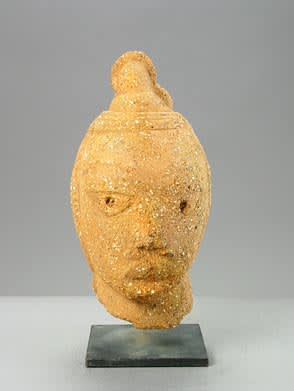Nok Terracotta Head of a Woman, 500 BCE - 200 CE
Terracotta
10.8 x 22.9 cm
4 1/4 x 9 in
4 1/4 x 9 in
PF.5865
Some of the earliest examples of sophisticated sculpture in sub-Saharan Africa come from the Nok culture. We do not know what the people called themselves, so the culture was named...
Some of the earliest examples of sophisticated sculpture in sub-Saharan Africa come from the Nok culture. We do not know what the people called themselves, so the culture was named after the town of Nok where the first object was found. The fired clay or terracotta sculptures range in size from small pendant to life-size figures. Nok is an Iron Age culture that has been dated between 900 B.C. and 200 A.D. Archaeological artifacts have been found in Nigeria, primarily to the north of the Niger-Benue River confluence and below the Jos escarpment. According to some accounts, based on artistic similarities between early Yoruba art forms and Nok forms, there may be connections between Nok culture and contemporary Yoruba peoples. What is clear is that certain stylistic tendencies prevalent in black African art today may have originated in the sculptures of the Nok.
This fragment of a head is a perfect example of the Nok type, from the material itself to the carving of the forms. The distinctive orange clay, rich with mineral deposits that appear as white spots, is characteristic of Nok art. Other facial features, including the large almond-shaped eyes, the drilled holes representing the pupils (now partially filled by sediment), and the elaborate coiffure are all trademarks of the Nok style. This woman wears an ornate coiffure with two projecting mounds on the top of her head that probably symbolized her high-ranking status. Intricate indentations delineate the individual locks as they fall along the back of her head and cover her ears. There is a reserved, composed air about her expression that is befitting of royalty. She appears stern and yet elegant, controlled but naturally beautiful. Her hypnotic gaze asserts her strength and confidence. Surely she must have been an extremely important individual in order to be memorialized in such a stunning sculpture, most likely she is a princess or a young mother queen.
This fragment of a head is a perfect example of the Nok type, from the material itself to the carving of the forms. The distinctive orange clay, rich with mineral deposits that appear as white spots, is characteristic of Nok art. Other facial features, including the large almond-shaped eyes, the drilled holes representing the pupils (now partially filled by sediment), and the elaborate coiffure are all trademarks of the Nok style. This woman wears an ornate coiffure with two projecting mounds on the top of her head that probably symbolized her high-ranking status. Intricate indentations delineate the individual locks as they fall along the back of her head and cover her ears. There is a reserved, composed air about her expression that is befitting of royalty. She appears stern and yet elegant, controlled but naturally beautiful. Her hypnotic gaze asserts her strength and confidence. Surely she must have been an extremely important individual in order to be memorialized in such a stunning sculpture, most likely she is a princess or a young mother queen.
